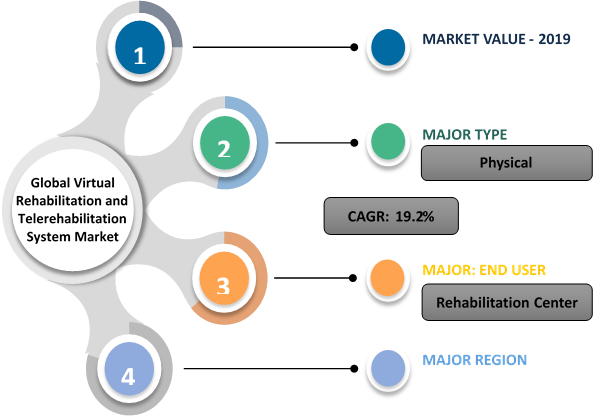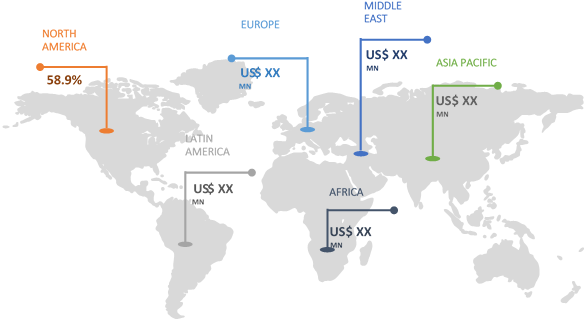In the recent years, various technological advancements have been made in the virtual rehabilitation (VR) and telerehabilitation systems. These includes technologies such as high-end and low-end systems, embedded ambient VR technologies to monitor real world activity, and turn-key VR systems with clinical validity and reliability. Moreover, manufacturers are also focused on VR applications with a personalized medicine approach. Therefore, technological advancements in rehabilitation systems is expected to drive growth of the virtual rehabilitation and telerehabilitation system market.
The global virtual rehabilitation and telerehabilitation system market is estimated to be valued at US$ 192.7 million in 2019 and is expected to witness a CAGR of 19.2% during the forecast period (2019 – 2027).
Figure 1. Global Virtual Rehabilitation and Telerehabilitation System Market Overview

To learn more about this report, Download Free Sample
Source: Coherent Market Insights Analysis (2019)
Increasing initiatives by research institutes and major key players to develop technologically advanced virtual reality rehabilitation devices is expected to drive growth of the virtual rehabilitation and telerehabilitation system market
Key players in the market are focusing on development of technologically advanced virtual rehabilitation and telerehabilitation systems for highly prevalent diseases and launching them in the market. For instance, in March 2019, Neuro Rehab VR, U.S.-based company and The University of North Texas Health Science Center partnered with the University of Texas at Arlington Research Institute (UTARI). The University of Texas at Arlington Research Institute is developing flexible soft robotic gloves that will aid in rehabilitating stroke patients through virtual reality gaming. Combining this glove with the virtual reality gaming to be developed by Neuro Rehab VR will enable stroke patients to engage in rehabilitation activities for regaining their hand function. Thus, development of such innovative products is expected to drive the market growth over the forecast period.
Acquisitions by key players in order to enhance the at-home telerehabilitation capability is contributing to virtual rehabilitation and telerehabilitation system market growth. For instance, in October 2016, Zimmer Biomet Holdings Inc. acquired RespondWell, a telerehabilitation platform from RespondWell LLC. Zimmer Biomet integrated the novel platform into its Zimmer Biomet Signature Solutions to further enhance patient compliance with physical therapy.
However, lack of awareness among healthcare professionals about novel technologies and advanced therapies is expected to decrease adoption of virtual rehabilitation and telerehabilitation systems in rural areas of emerging economies in regions such as Asia Pacific. Moreover, lack of skilled professionals is also expected to hamper growth of the global virtual rehabilitation and telerehabilitation system market during the forecast period.
Virtual Rehabilitation and Telerehabilitation System Market - Regional Analysis
On the basis of the region, the global virtual rehabilitation and telerehabilitation system market is segmented into North America, Latin America, Europe, Asia Pacific, Middle East, and Africa.
North America is expected to exhibit significant growth in the virtual rehabilitation and telerehabilitation system market, owing to presence of major players such as Bridgeway Senior Healthcare and Virtualware Group. Moreover, developed healthcare infrastructure and various policies supporting telerehabilitation are also expected to aid in growth of the market in North America.
Asia Pacific is also expected to drive growth of the virtual rehabilitation and telerehabilitation system market, owing to increasing disability cases in the region. For instance, according to Central Government and Disability Census in India, in 2016, around 26.8 million people were disabled, which represented 2.21% of the total population. Moreover, increasing healthcare expenditure and rising awareness among the population in the region is contributing to growth of the Asia Pacific virtual rehabilitation and telerehabilitation system market.
Europe is expected to exhibit significant growth, owing to increasing number of approvals from the European Union for virtual reality rehabilitation devices. For instance, in February 2016, MindMaze received CE marking for its Immersive Virtual Reality (IVR) rehabilitation solution, MindMotionPRO, for neurological rehabilitation. MindMotionPRO is a hospital-based rehabilitation solution for early motor intervention in neurological patients.
Figure 2: Global Virtual Rehabilitation and Telerehabilitation System Market Share (%), By Region, 2018

To learn more about this report, Download Free Sample
Source: Coherent Market Insights Analysis (2019)
Virtual Rehabilitation and Telerehabilitation System Market - Competitive Landscape
Key players operating in the virtual rehabilitation and telerehabilitation system market include Reflexion Health, Inc., 270 Vision Ltd., CoRehab srl, Hinge Health, Inc., SWORD Health, S.A., MIRA Rehab Limited, Bridgeway Senior Healthcare, Motekforce Link, GestureTek Inc., Virtualware Group, Motorika Medical Ltd., LiteGait, Doctor Kinetic, and Mindmaze.
Share
Share
Missing comfort of reading report in your local language? Find your preferred language :
Transform your Strategy with Exclusive Trending Reports :
Frequently Asked Questions
Select a License Type
Joining thousands of companies around the world committed to making the Excellent Business Solutions.
View All Our Clients